1994 PONTIAC BONNEVILLE light
[x] Cancel search: lightPage 4 of 290
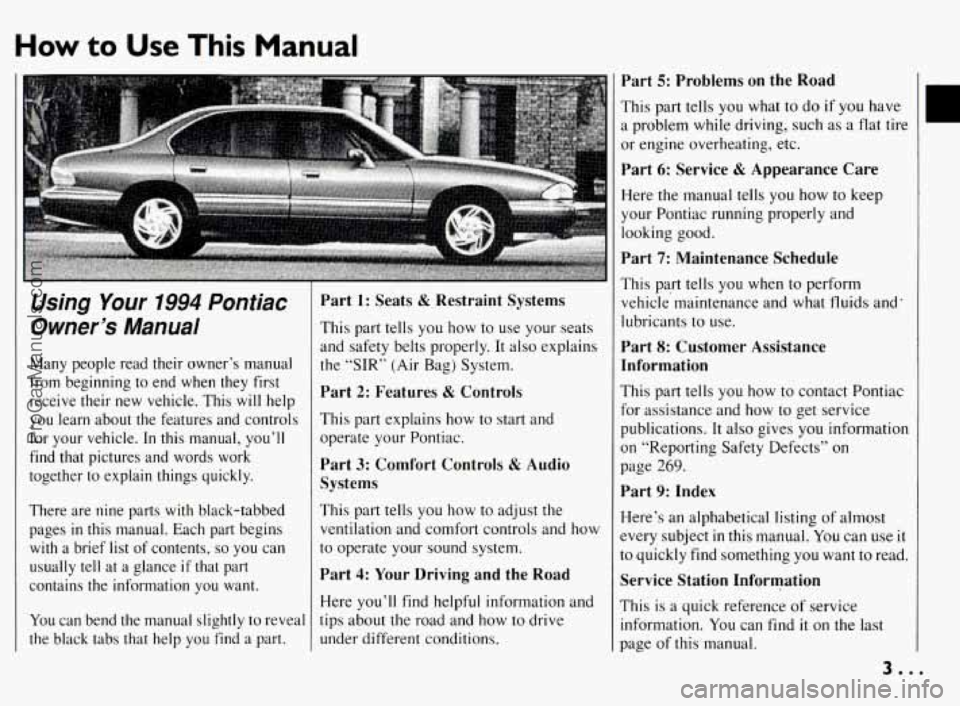
How to Use This Manual
Using Your 1994 Pontiac
Owner’s Manual
Many people read their owner’s manual
from beginning
to end when they first
receive their
new vehicle. This will help
you learn about the features and controls
for your vehicle. In this manual, you’ll
find that pictures and words work
together
to explain things quickly.
There are nine parts with black-tabbed pages
in this manual. Each part begins
with a brief list of contents,
so you can
usually tell at a glance
if that part
contains the information you want.
You can bend the manual slightly to reveal
the black tabs that help you find a part.
This part tells you how to use your seats
and safety belts properly. It also explains
the “SIR’ (Air Bag) System.
Part 2: Features & Controls
This part explains how to start and
operate your Pontiac.
Part 3: Comfort Controls & Audio
Systems
This part tells you how to adjust the
ventilation and comfort controls and how
to operate your sound system.
Part 4: Your Driving and the Road
Here you’ll find helpful information and
tips about the road and how
to drive
under different conditions.
Part 5: Problems on the Road
This part tells you what to do if you have
a problem while driving, such as a flat tire
or engine overheating, etc.
Part 6: Service & Appearance Care
Here the manual tells you how to keep
your Pontiac running properly and
looking good.
Part 7: Maintenance Schedule
This part tells you when to perform
vehicle’maintenance and what fluids and’
lubricants to use.
Part 8: Customer Assistance
Information
This part tells you how to contact Pontiac
for assistance and how
to get service
publications. It also gives
you information
on “Reporting Safety Defects”
on
page 269.
Part 9: Index
Here’s an alphabetical listing of almost
every subject
in this manual. You can use it
to quickly find something you want to read.
Service Station Information
This is a quick reference of service
information.
You can find it on the last
page of this manual.
3..
ProCarManuals.com
Page 6 of 290
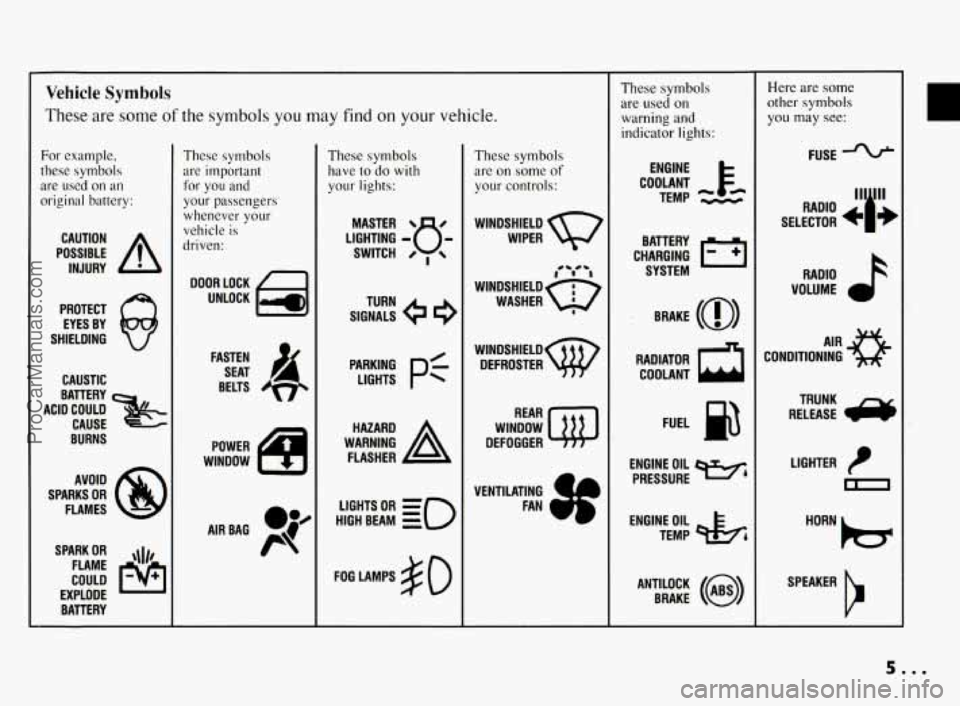
Vehicle Symbols
These are some of the symbols you may find on your vehicle.
For example,
these symbols
are used on an
original battery:
POSSIBLE A
CAUTION
INJURY
PROTECT EYES BY
SHIELDING
CAUSTIC
ACID COULD BATTERY
CAUSE
BURNS
AVOID
SPARKS
OR
FLAMES
SPARK
OR ,111,
COULD FLAME
EXPLODE BATTERY
These symbols
are important
for you and
your passengers
whenever your
vehicle
is
driven:
DOOR LOCK
UNLOCK
FASTEN SEAT
4
BELTS
POWER
WINDOW
'* -- I
These symbols
have to do with
your lights:
SIGNALS e
TURN
HIGH BEAM
OR = =o
FOG LAMPS $0
These symbols
are
on some of
your controls:
WIPER Q7
WINDSHIELD
DEFROSTER
WINDOW
DEFOGGER
VENTILATING
4
FAN (I
These symbols
are used
on
warning and
indicator lights:
COOLANT Fa
TEMP --
ENGINE
CHARGING
I-1
BATTERY SYSTEM
BRAKE
(0)
RADIATOR COOLANT
FUEL
ENGINE OIL
PRESSURE
Wb
TEMP OIL ?b
ANTILOCK (@)
BRAKE
Here are some
other symbols
you may see:
FUSE
11lp RADIO , - -
SELECTOR b I JE
RADIO
VOLUME
CONDITIONING
AIR 43
LIGHTER
m
SPEAKER
b
5.00
ProCarManuals.com
Page 12 of 290
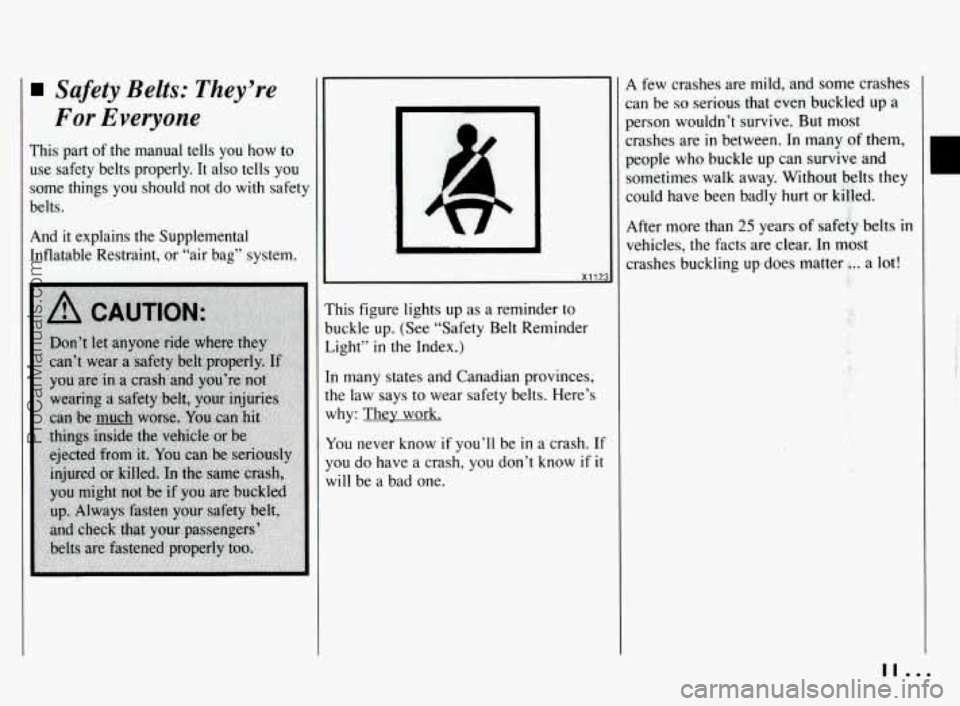
Safety Belts: They’re
For Everyone
This part of the manual tells you how to
use safety belts properly. It also tells you
some things you should not do with safety
belts
.
And it explains the Supplemental
Inflatable Restraint, or “air bag” system.
This figure lights up as a reminder to
buckle
up. (See “Safety Belt Reminder
Light”
in the Index.)
In many states and Canadian provinces,
the law says to wear safety belts. Here’s
why: They work.
You never know if you’ll be in a crash. If
you do have a crash, you don’t know
if it
will be a bad one.
A few crashes are mild, and some crashes
:an be
so serious that even buckled up a
person wouldn’t survive.
But most
:rashes are
in between. In many of them,
people who buckle up can survive and
sometimes walk away. Without belts they
could have been badly hurt or killed.
After more than
25 years of safeiy belts in
vehicles, the facts are clear. In most
crashes buckling up does matter
4.. a lot!
.:5 ”
,? , ‘i I
,
r
II ...
ProCarManuals.com
Page 16 of 290
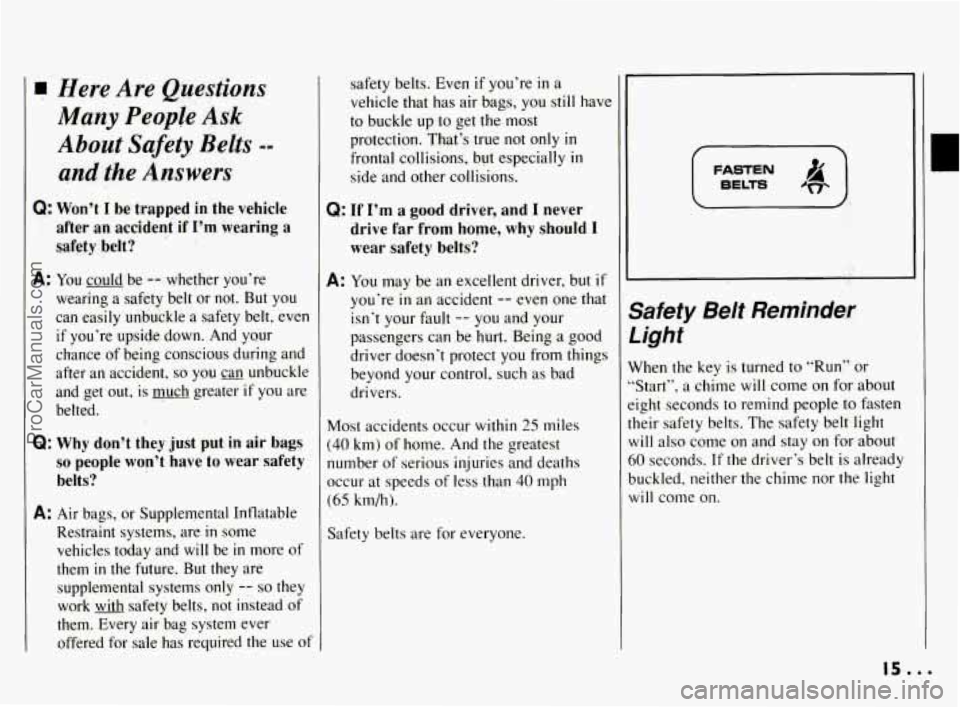
Here Are Questions
Many People Ask
About Safety Belts --
and the Answers
Q: Won’t I be trapped in the vehicle
after an accident if
I’m wearing a
safety belt?
A: You could be -- whether you’re
wearing a safety belt
or not. But you
can easily unbuckle a safety belt, even
if you’re upside down. And your
chance of being conscious during and
after an accident,
so you can unbuckle
and get
out, is much greater if you are
belted.
Q: Why don’t they just put in air bags
so people won’t have to wear safety
belts?
A: Air bags, or Supplemental Inflatable
Restraint systems, are
in some
vehicles today and
will be in more of
them in the future. But they are
supplemental systems only
-- so they
work safety belts, not instead
of
them. Every air bag system ever
offered for sale has required the use of safety belts.
Even
if you’re in a
vehicle that has air bags, you still have
to buckle up to get the most
protection. That’s true not only
in
frontal collisions, but especially in
side and other collisions.
Q: If I’m a good driver, and I never
drive far from home, why should
I
wear safety belts?
A: You may be an excellent driver, but if
you’re in an accident -- even one that
isn’t your fault
-- you and your
passengers can be hurt. Being a good
driver doesn’t protect you from things
beyond your control, such as bad
drivers.
Most accidents occur within 25 miles
(40 km) of home. And the greatest
number of serious injuries and deaths
occur at speeds
of less than 40 mph
(65 km/h).
Safety belts are for everyone.
BELTS
Safety Belt Reminder
Light
Yhen the key is turned to “Run” or
Start”, a chime will come on for about
ight seconds to remind people
to fasten
heir safety belts. The safety belt light
vi11 also come on and stay on for about
10 seconds. If the driver’s belt is already
buckled, neither the chime nor the light
vill come on.
C
15...
ProCarManuals.com
Page 23 of 290
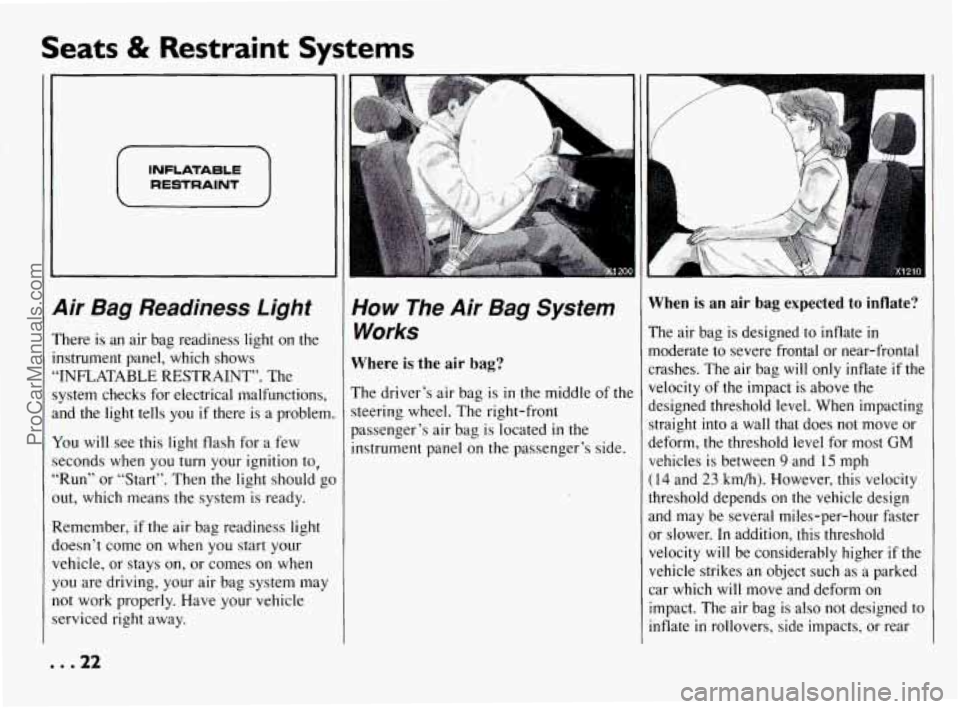
Seats & Restraint Systems
INFLATABLE
RESTRAINT
9ir Bag Readiness Light
’here is an air bag readiness light on the
xtrument panel, which shows
INFLATABLE RESTRAINT”. The
ystem checks for electrical malfunctions,
nd the light tells you
if there is a problem.
’ou will see this light flash for a few
xonds when
you turn your ignition to,
Run” or “Start”. Then the light should gc
ut, which means the system is ready.
.emember, if the air bag readiness light
oesn’t come on when you start your
ehicle, or stays on, or comes
on when
ou are driving, your air bag system may
ot work properly. Have your vehicle xviced right away.
. .22
I
HOW The Air Bag System When is an air bag expected to inflate?
moderate to severe frontal or near-frontal
Works The air bag is designed to inflate in
Where is the air bag? crashes. The air bag will only inflate if the
The driver’s air bag is
in the middle of the
steering wheel. The right-front
passenger’s air bag is located
in the
instrument panel
on the passenger’s side. velocity
of the impact is above the
designed threshold level. When impacting straight into a wall that does not move or
deform, the threshold level for most GM
vehicles is between 9 and 15 mph
(14 and 23 km/h). However, this velocity
threshold depends on the vehicle design
and may be several miles-per-hour faster or slower. In addition, this threshold
velocity will be considerably higher
if the
vehicle strikes an object such as a parked
car which will move and deform on impact. The air bag is also not designed to
inflate
in rollovers, side impacts, or rear
ProCarManuals.com
Page 46 of 290
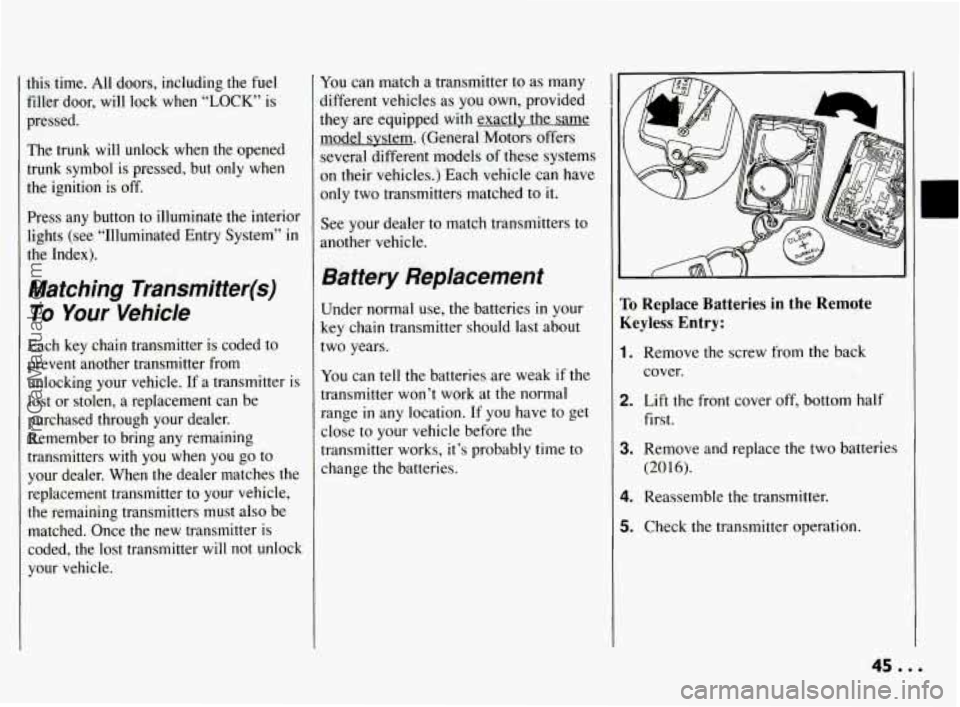
this time. All doors, including the fuel
filler door,
will lock when “LOCK” is
pressed.
The trunk
will unlock when the opened
trunk symbol is pressed, but only when
the ignition is off.
Press any button to illuminate the interior
lights (see “Illuminated Entry System’’
in
the Index).
Matching Transmitter(s)
To Your Vehicle
Each key chain transmitter is coded to
prevent another transmitter from
unlocking your vehicle. If a transmitter is
lost or stolen,
a replacement can be
purchased through your dealer.
Remember
to bring any remaining
transmitters
with you when you go to
your dealer. When the dealer matches the
replacement transmitter to your vehicle,
the remaining transmitters
must also be
matched. Once the new transmitter is
coded, the lost transmitter
will not unlock
your vehicle.
You can match a transmitter to as many
different vehicles as
you own, provided
they are equipped with exactlv the same
model system. (General Motors offers
several different models of these systems
on their vehicles.) Each vehicle can have
only two transmitters matched to it.
See your dealer to match transmitters to
another vehicle.
Battery Replacement
Under normal use, the batteries in your
key chain transmitter should last about
two years.
You can tell the batteries are weak if the
transmitter won’t work at the normal
range
in any location. If you have to get
close to your vehicle before the
transmitter works, it’s probably time
to
change the batteries.
ro Replace Batteries in the Remote
Keyless Entry:
I. Remove the screw from the back
cover.
2. Lift the front cover off, bottom half
first.
3. Remove and replace the two batteries
(2016).
4. Reassemble the transmitter.
i. Check the transmitter operation.
45e.o
ProCarManuals.com
Page 48 of 290
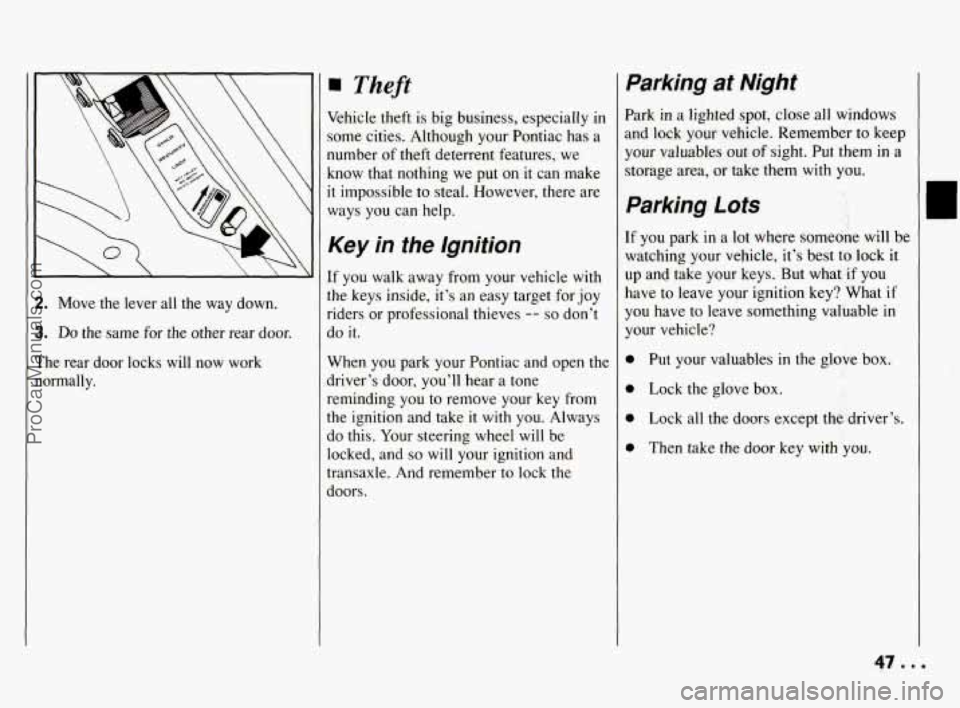
2. Move the lever all the way down.
3. Do the same for the other rear door.
The rear door locks will now work
normally.
Theft
Vehicle theft is big business, especially in
some cities. Although your Pontiac has a
number
of theft deterrent features, we
know that nothing we put on
it can make
it impossible to steal. However, there are
ways you can help.
Key in the lgnition
If you walk away from your vehicle with
the keys inside,
it’s an easy target for joy
riders or professional thieves
-- so don’t
do it.
When you park your Pontiac and open the
driver’s door, you’ll hear a tone
reminding you
to remove your key from
the ignition and take it with you. Always
do this. Your steering wheel will be
locked, and
so will your ignition and
transaxle. And remember to lock the
doors.
Parking at Night
Park in a lighted spot, close all windows
and lock your vehicle. Remember
to keep
your valuables out
of sight. Put them in a
storage area, or take them with you.
Parking Lots
If you park in a lot where someone will be
watching your vehicle, it’s best to lock
it
up and take your keys. But what if you
have
to leave your ignition key? What if
you have to leave something valuable in
your vehicle?
0 Put your valuables in the glove box.
0 Lock the glove box.
0 Lock all the doors except the driver’s.
0 Then take the door key with you.
47.0.
ProCarManuals.com
Page 49 of 290
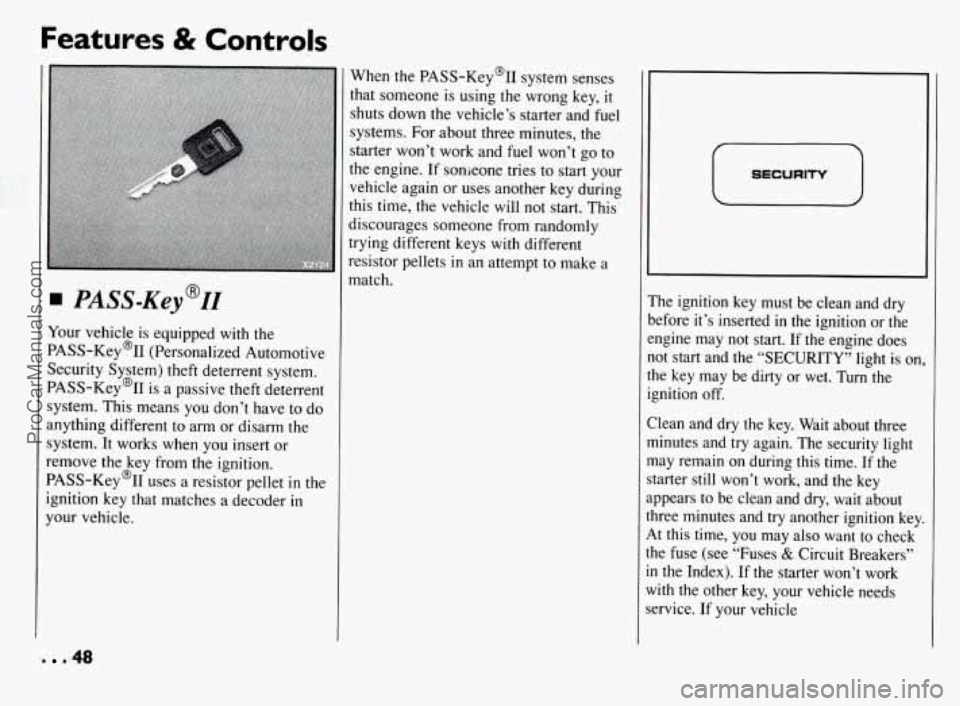
Features & Controls
Your vehicle is equipped with the
PASS-Key’II (Personalized Automotive
Security System) theft deterrent system.
PASS-Key’II is a passive theft deterrent
system. This means you don’t have to do
anything different to arm or disarm the
system. It works when you insert or
remove the key from the ignition.
PASS-Key@II uses a resistor pellet
in the
ignition key that matches a decoder
in
your vehicle. When
the PASS-Key@II system senses
that someone is using the wrong key,
it
shuts down the vehicle’s starter and fuel
systems. For about three minutes, the
starter won’t work and
fuel won’t go to
the engine. If someone tries to start your
vehicle again or uses another key during
this time, the vehicle will not start. This
discourages someone from randomly
trying different keys with different
resistor pellets in an attempt to make a
match.
7 SECURITY
The ignition key must be clean and dry
before it’s inserted in the ignition or the
engine may not start. If the engine does
not start and the “SECURITY” light is on,
the key may be dirty or wet. Turn the
ignition off.
Clean and dry the key. Wait about three
minutes and try again. The security tight
may remain on during this time. If the
starter still won’t work, and the key
ippears to be clean and dry, wait about
:hree minutes and try another ignition key.
4t this time, you may also want to check
the fuse (see “Fuses
& Circuit Breakers”
in the Index). If the starter won’t work
with the other key, your vehicle needs
service. If your vehicle
. -48
ProCarManuals.com